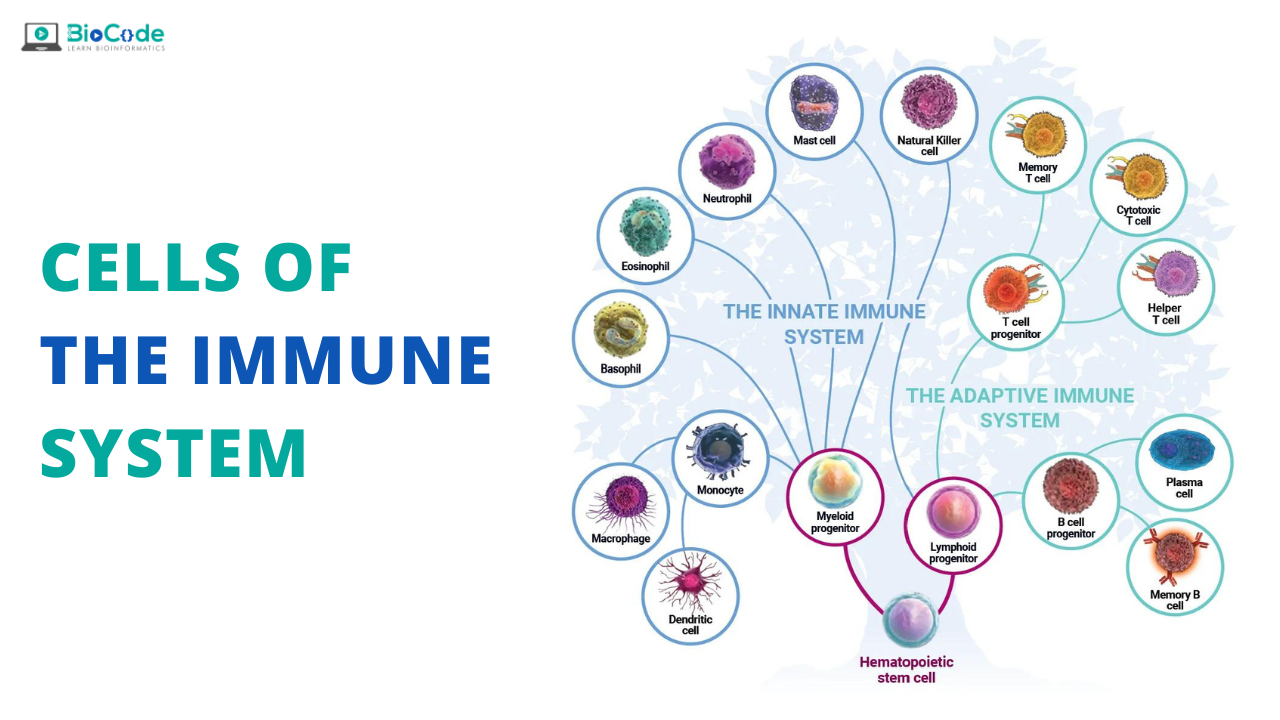Cells of the Immune System:
The cells of the immune system are located at different tissues and serve different roles in host defense.
Granulocytes:
Granulocytes are at the front lines of attack during an immune response. They are a part of the innate immune system. Granulocytes are white blood cells (leukocytes) that are classified as neutrophils, basophils, mast cells, or eosinophils based on differences in cellular morphology and the staining of their characteristic cytoplasmic granules. All granulocytes have multi lobed nuclei that make them visually distinctive and easily distinguishable from lymphocytes, whose nuclei are round. The cytoplasm of all granulocytes is replete with granules that are released in response to contact with pathogens. These granules contain a variety of proteins with distinct functions. Granulocytes includes mast cells, neutrophils, basophiles and eosinophiles. Proteins like proteases, Histamines, ribonucleases, and Lipid mediators are present inside the cytoplasm of the granulocytes in the form of granules.
Tissues of the Immune System:
The tissues of the immune system consist of the generative lymphoid organs, in which T and B lymphocytes mature and become competent to respond to antigens. And the peripheral lymphoid organs, in which adaptive immune response to microbes are initiated.
Lymphocytes:
Lymphocytes are the only cells that produce clonally distributed receptors specific for diverse antigens and are the key mediators of adaptive immunity. These cells often are distinguishable by surface proteins that may be identified using panels of monoclonal antibodies. The standard nomenclature for these proteins is the CD (cluster of differentiation) numerical designation, which is used to delineate surface proteins that define a particular cell type or stage of cell differentiation. B lymphocytes are the only cells capable of producing antibodies, therefore they are the cells that mediate humoral immunity. T lymphocytes are responsible for cell-mediated immunity. The antigen receptors of most T lymphocytes recognize only peptide fragments of protein antigens that are bound to specialized peptide display molecules, called major histocompatibility complex (MHC) molecules, on the surface of specialized cells, called antigen-presenting cells.
⦁ CD4+ T cells
Among T lymphocytes, CD4+ T cells are called helper T cells because they help B lymphocytes to produce antibodies. Effector CD4+ T cells produce proteins called cytokines that activate B cells, macrophages, and other cell types, which mediate the helper function of this lineage.It also help phagocytes to destroy ingested microbes.
⦁ CD8+ T lymphocytes
CD8+ T lymphocytes are called cytotoxic T lymphocytes (CTLs) because they kill cells harboring intracellular microbes. B lymphocytes mature in the bone marrow, and T lymphocytes mature in an organ called the thymus. When naive lymphocytes recognize microbial antigens and receive additional signals induced by microbes, the antigen-specific lymphocytes proliferate and differentiate into effector cells and memory cells. Naive lymphocytes express receptors for antigens but do not perform the functions that are required to eliminate antigens. These cells reside in and circulate between peripheral lymphoid organs and survive for several weeks or months, waiting to find and respond to antigen. Effector lymphocytes are the differentiated progeny of naive cells that can produce molecules that function to eliminate antigens. The effector cells in the B lymphocyte lineage are antibody-secreting cells, called plasma cells.
Memory cells, also generated from the progeny of antigen-stimulated lymphocytes, do survive for long periods in the absence of antigen. Memory cells are functionally inactive; they do not perform effector functions unless stimulated by antigen. When memory cells encounter the same antigen that induced their development, the cells rapidly respond to initiate secondary immune responses.
Maturation of lymphocytes:
Lymphocytes develop from precursors in the generative lymphoid organs (bone marrow and thymus). Mature lymphocytes enter the peripheral lymphoid organs, where they respond to foreign antigens and recirculate in the blood and lymph. Some immature B cells leave the bone marrow and complete their maturation in the spleen.
Classes of lymphocytes:
Different classes of lymphocytes in the adaptive immune system recognize distinct types of antigens and differentiate into effector cells whose function is to eliminate the antigens.
B lymphocytes recognize soluble or cell surface antigens and differentiate into antibody-secreting cells.
Helper T lymphocytes recognize antigens on the surfaces of antigen-presenting cells and secrete cytokines, which stimulate different mechanisms of immunity and inflammation.
Cytotoxic T lymphocytes recognize antigens in infected cells and kill these cells. Regulatory T cells limit the activation of other lymphocytes, especially of T cells, and prevent autoimmunity.
Antigen-Presenting Cells:
The common portals of entry for microbes are the skin, gastrointestinal tract, and respiratory tract. They contain specialized antigen-presenting cells (APCs) located in the epithelium that capture antigens. They are then transport to peripheral lymphoid tissues and are displayed to lymphocytes. This function of antigen capture, and presentation is best understood for a cell type that is called dendritic cells because of their long surface membrane processes. Dendritic cells capture protein antigens of microbes that enter through the epithelia. They transport the antigens to regional lymph nodes, where the antigen-bearing dendritic cells display portions of the antigens for recognition by T lymphocytes. These specialized cells respond to microbes by producing surface and secreted proteins that are required, together with antigen. These proteins help to activate naive T lymphocytes to proliferate and differentiate into effector cells.
Monocytes:
During hematopoiesis in the bone marrow, granulocyte-monocyte progenitor cells differentiate into promonocytes, which leave the bone marrow and enter the blood, where they further differentiate into mature monocytes. Monocytes that migrate into tissues in response to infection can differentiate into specific tissue macrophages. Osteoclasts in the bone, microglial cells in the central nervous system, and alveolar macrophages in the lung are tissue-specific examples of macrophages with these properties.

